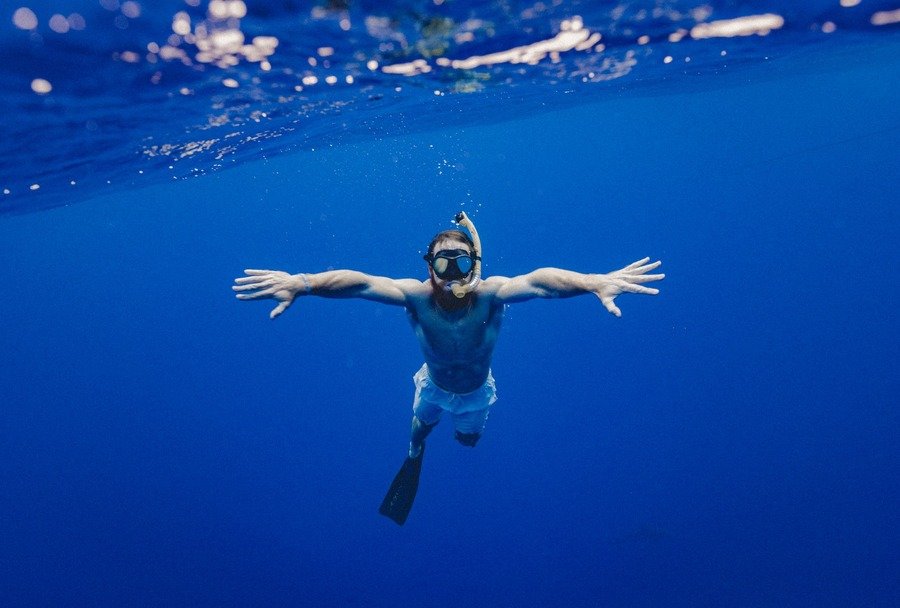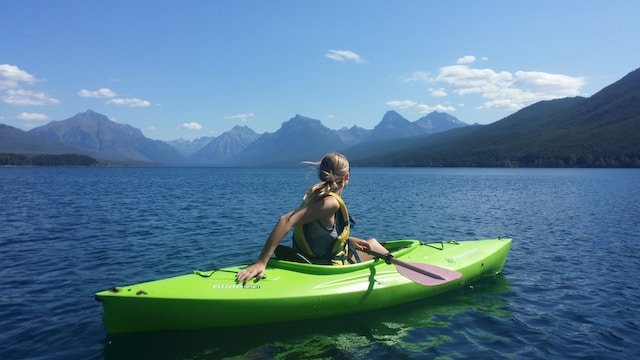Do You Need to Know How to Swim to Kayak?

The idea of kayaking typically conjures up images of gliding along a serene river or exploring a craggy coastline. Kayaking has captured the imagination of outdoor enthusiasts all over the world.
But before you go off on this exciting journey, one important issue needs to be answered: is swimming a prerequisite for kayaking? This article will look at the relationship between swimming and kayaking and how important swimming is when kayaking.
What is Kayaking?
To begin, let’s define kayaking. Kayaking is a water-based activity where individuals navigate small, narrow watercraft called kayaks using a double-bladed paddle.
It can encompass various forms, from leisurely paddling on calm lakes to tackling challenging whitewater rapids or venturing into the open sea for sea kayaking adventures. The versatility of kayaking makes it an attractive option to those craving a link to nature and an adrenaline rush.
Its rising appeal spans across ages and expertise levels, presenting a distinctive chance to navigate water paths, witness wildlife, and commune with nature.
Whether you crave tranquility on a calm lake or the exhilaration of rapid river runs, kayaking accommodates diverse preferences. As more individuals embrace this sport, the question of swimming proficiency becomes increasingly relevant.
Importance of Safety in Kayaking
Before we address the necessity of swimming skills in kayaking, it’s essential to underscore the paramount importance of safety in this activity. Kayaking is generally a safe and enjoyable pursuit when done responsibly.
However, like any water-based activity, it comes with inherent risks. These risks include capsizing, changing weather conditions, strong currents, and unexpected obstacles.
To mitigate these risks and ensure a safe kayaking experience, individuals must prioritize safety measures such as wearing appropriate personal flotation devices (PFDs), being aware of weather forecasts, and acquiring the necessary kayaking skills.
Importance of Swimming Skills
While swimming is not an absolute requirement for kayaking, swimming skills can enhance your kayaking experience and safety. Being great at swimming instills confidence when you’re on the water.
Knowing that you can navigate and stay afloat if you encounter unexpected situations boosts your overall confidence level.
Confidence leads to a more enjoyable kayaking experience. It allows you to explore new waters, try different kayaking techniques, and handle challenging conditions with poise.
Also, accidents can happen in kayaking, from capsizing to getting caught in strong currents. Swimming skills enable you to respond effectively to these situations, helping you stay safe.
Knowing how to swim well can make the difference between a small inconvenience and a potentially dangerous situation in an emergency. It gives you the ability to save yourself or save others when necessary.
Though it’s helpful, having a high swimming ability isn’t necessary for kayaking. It’s usually enough to know how to swim just enough to get by, including floating, treading water, and using a few strokes.
Even rudimentary swimming abilities can provide a safety buffer, especially in calm waters where the likelihood of capsizing is lower.
In other words, swimming and kayaking are complementary skills, not mutually exclusive. Kayaking emphasizes paddling techniques, handling the kayak, and reading water conditions.
Having both swimming and kayaking skills makes you a well-rounded water enthusiast. You can enjoy the benefits of both activities and be better prepared for various scenarios on the water.
Safety Precautions in Kayaking
Safety is paramount in kayaking, and understanding and following these precautions can make your kayaking adventures both enjoyable and safe.
Always wear a PFD
The single most important safety measure in kayaking is wearing a Personal Flotation Device (PFD): A PFD is your lifeline on the water. It keeps you afloat and provides buoyancy in case of emergencies.
Wearing a PFD is non-negotiable. It should be properly fitted, secured, and worn at all times while kayaking, irrespective of your swimming ability.
Kayak with a friend or group
Kayaking with others enhances safety in multiple ways. The “buddy system” ensures that there is someone to assist you in case of trouble. In a group, experienced kayakers can provide guidance to less experienced paddlers.
In emergencies, having a buddy or group increases the chances of quick rescue and support. It also builds friendships and shared experiences.
Understand Water Conditions
Knowing the water conditions you’re navigating is important for your safety. Recognizing the difference between calm and turbulent waters is essential.
Calm waters are ideal for beginners, while turbulent waters, such as whitewater, require advanced skills. Choose waters that match your skill level to avoid challenges you might not be able to handle.
It is also necessary for every kayaker to understand water currents and tidal patterns, especially in coastal and river kayaking.
Tides and currents can affect your paddling speed and direction. Being aware of these natural forces allows you to plan your route, conserve energy, and avoid potentially hazardous areas.
Proper Kayak Entry and Exit Techniques
Proper entry and exit of a kayak is an essential kayaking skill you should have as a kayaker regardless of your level. Learn proper techniques for getting in and out of your kayak, which may involve wading in shallow water or launching from a dock or shore.
Incorrect entry or exit can result in instability and potential capsizing. Proper techniques ensure a stable start and finish to your kayaking journey.
How to Handle Capsizing Situations
While on the water, there are chances of a capsize. It is therefore important to know how to handle a capsize if you happen to experience one.
Learn self-rescue techniques, including how to re-enter your kayak and paddle effectively after a capsize. Being prepared for capsizing situations minimizes panic and helps you regain control swiftly.
Importance of Weather Awareness
Watch the weather reports both in advance of and throughout your kayaking excursion. Keep an eye out for indicators of shifting weather, such as unexpected dips in temperature, strong gusts, or gloomy clouds.
Knowing the weather will help you make wise decisions, such as deciding when to abbreviate or postpone your journey in order to avoid hazardous conditions like strong currents or storms.
Learning to Swim for Kayaking
If you’re considering kayaking but lack swimming skills, it’s never too late to learn. It is advised that before you go kayaking, you should acquire fundamental swimming skills like treading water, floating, and simple strokes to help you navigate the water if and when needed.
You can learn swimming and kayaking simultaneously to fast-track your journey to becoming a competent kayaker with good swimming skills:
While swimming skills can enhance safety in kayaking, it is not an absolute requirement. It is possible to enjoy kayaking without knowing how to swim.
Situations Where Swimming Skills May Not Be Required
1. Recreational Kayaking in Calm Waters
Recreational kayaking in serene, calm waters, such as lakes or slow-moving rivers, is generally a low-risk activity. In these tranquil settings, the likelihood of capsizing or encountering strong currents is minimal. Hence, beginners and non-swimmers can comfortably enjoy kayaking.
2. Guided Kayaking Tours with Experienced Guides
Many guided kayaking tours are led by experienced and certified guides who prioritize safety. When kayaking with guides, non-swimmers can rely on their expertise. Guides are equipped with safety gear, knowledge of local conditions, and the ability to provide assistance if needed.
Risk Factors and Limitations
While kayaking without swimming skills is feasible in certain situations, it’s crucial to acknowledge the risk factors and limitations.
- Limited Versatility: Non-swimmers may need to limit their kayaking activities to calm and controlled environments, missing out on more challenging and exhilarating kayaking experiences.
- Dependency on Safety Measures: Non-swimmers rely heavily on safety equipment, such as Personal Flotation Devices (PFDs), and adhere to safety guidelines to reduce risks.
- Risk of Panic: In unexpected situations, non-swimmers may experience heightened anxiety or panic, which can impair decision-making. Staying calm is crucial.
Precautions for Non-Swimmers when Kayaking
When non-swimmers go kayaking, they need to take extra safety measures, like:
- Always Wear a PFD: Regardless of swimming expertise, every kayaker must wear a properly fitting PFD consistently during kayaking. This is a safety measure that is not negotiable.
- Stay in Calm Waters: Choose kayaking locations that are known for their calm and gentle waters. Avoid areas with strong currents or challenging conditions.
- Kayak with Experienced Paddlers: Whenever possible, kayak with experienced friends or on guided tours with trained instructors who can provide guidance and assistance.
- Learn Basic Self-Rescue Techniques: Even without advanced swimming skills, non-swimmers can benefit from learning basic self-rescue techniques specific to kayaking, such as how to re-enter a capsized kayak.
- Communicate Any Concerns: Inform your kayaking companions and guides about your swimming limitations or any concerns you may have.
To sum up, kayaking opens up a world of discovery, adventure, and tranquility. People of all backgrounds and ability levels can enjoy this sport.
To truly appreciate the beauty of kayaking, keep safety as your top priority, arm yourself with the appropriate information and equipment, and, if needed, think about learning how to swim to boost your confidence.
Whether you plan to kayak in serene lakes, untamed rivers, or stunning coastlines, remember to take responsibility for the water and treat it with respect as you set out on your adventure.
Savor the independence and closeness to the natural world that kayaking offers, and make sure you always come back from your expeditions with priceless memories and a dedication to the security of everyone around you.






